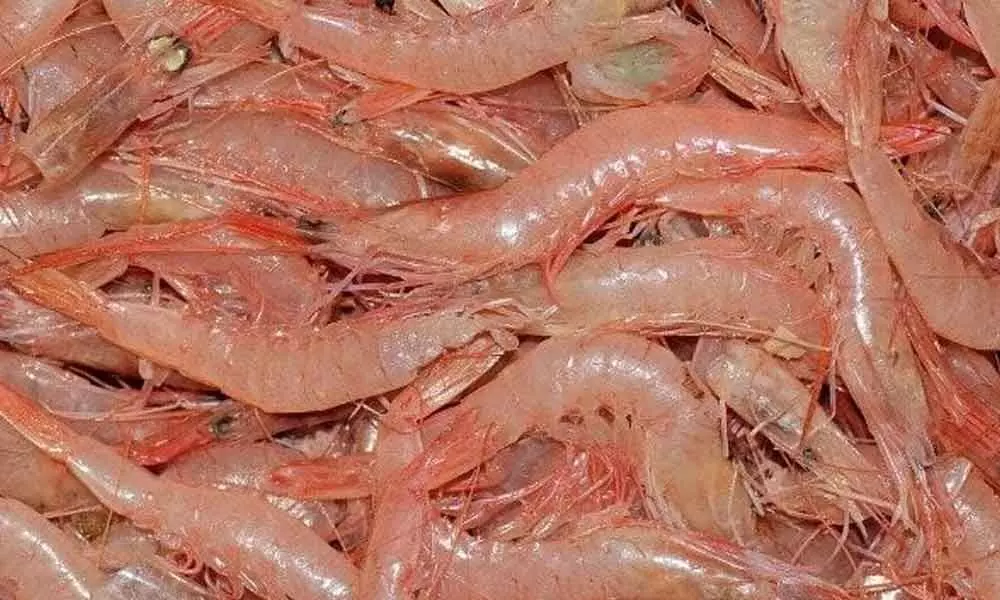Live
- CPI Narayana Hails Supreme Court's Dismissal of Petition to Amend Constitution's Preamble
- Book exhibition on Constitution organised
- Trump's proposed tariffs threaten North American jobs, says Mexican employers' association
- AP minister Savita pays tribute to Mahatma Jyotibapule on Death Anniversary
- Japan: Two die in fire at lawmaker's residence
- Navy braces up to deal with Cyclone Fengal brewing in Bay of Bengal
- Cake mixing celebrations held at KIMS College of Hotel Management
- Vijayawada CP inaugurates AP Police Sports and Games Meet
- Allu Arjun’s Special Tribute to Devi Sri Prasad at Pushpa 2 Event!
- Gold rates in Delhi today slashes, check the rates on 28 November, 2024
Just In
White spot affects shrimp culture in Nellore


Vannamei shrimp culture has been affected by white spot virus in the district, leading to low productivity.
Nellore: Vannamei shrimp culture has been affected by white spot virus in the district, leading to low productivity. Around 30,000 farmers are into the shrimp cultivation in the district and the farmers are demanding that the officials find a permanent solution to weed out the problem.
The virus is causing loss of revenue to the Sate exchequer.Development of shrimp farming is an important activity in coastal districts and the shrimp production has grown at a phenomenal rate during 1992-1994. Later it started decreasing due to outbreak diseases. Technological advancements have also led to growing shrimp in large extents.
The rapid growth of shrimp farming led to economic surge in the past. But the outbreak of viral diseases has slowed down the activity. The growth of shrimp farming had setbacks between 1999-2009 and subsequently the freshwater prawn farming was developed in India in 1999 due to a sudden surge in demand and also on account of a decline in marine shrimp production due to spread of white spot syndrome.
The shrimp farming gained momentum after the introduction of L Vannamei in 2009 and the culture area and production had been constantly increasing. Vannamei occupied more than 90 per cent of shrimp production, leading to increased exports and growth of foreign exchange. Andhra Pradesh is the country's leader in exports of marine products with an annual turnover of around Rs 24,000 crore and major chunk of revenue was from Nellore.
Experts said the production was affected by the onset of the symptoms that require emergency harvesting leading to losses. Weather conditions during monsoon have contributed to the growth of the white spot syndrome.
Seven major diseases such as white spot syndrome virus (WSSV), black gill disease (BGD), running mortality syndrome (RMS), loose shell syndrome (LSS), white faecal syndrome (WFS), white muscle disease (WMD) and infectious hypodermal and haematopoietic necrosis (IHHN) were found in L Vannamei culture ponds of all Nellore, Kavali and Gudur divisions a couple of years ago.
It was found that farms which adopted bio-security measures and without any dissolved oxygen (DO) problems were infected at lesser degree. Local traders blame the government for not taking up any measures or opening units of National Institutes though it is getting revenues from the district that earns huge foreign exchange.
Central Institute of Brackish water Aquaculture (CIBA), Coastal Aqua Authority (CAA), MPEDA, and many others have been operating from Tamil Nadu, Kerala and other states giving no priority for farmers in the district.
"Scientists occasionally visit and organise awareness sessions in name only. What is the use with these Central organisations when we are striving hard to earn huge revenues for the state exchequer, wondered the farmers.

© 2024 Hyderabad Media House Limited/The Hans India. All rights reserved. Powered by hocalwire.com






